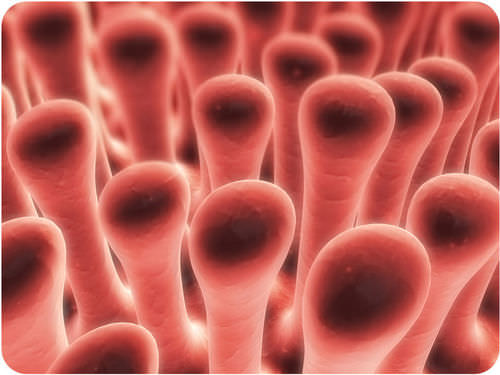13.29: Small Intestine
- Page ID
- 13304
\( \newcommand{\vecs}[1]{\overset { \scriptstyle \rightharpoonup} {\mathbf{#1}} } \)
\( \newcommand{\vecd}[1]{\overset{-\!-\!\rightharpoonup}{\vphantom{a}\smash {#1}}} \)
\( \newcommand{\dsum}{\displaystyle\sum\limits} \)
\( \newcommand{\dint}{\displaystyle\int\limits} \)
\( \newcommand{\dlim}{\displaystyle\lim\limits} \)
\( \newcommand{\id}{\mathrm{id}}\) \( \newcommand{\Span}{\mathrm{span}}\)
( \newcommand{\kernel}{\mathrm{null}\,}\) \( \newcommand{\range}{\mathrm{range}\,}\)
\( \newcommand{\RealPart}{\mathrm{Re}}\) \( \newcommand{\ImaginaryPart}{\mathrm{Im}}\)
\( \newcommand{\Argument}{\mathrm{Arg}}\) \( \newcommand{\norm}[1]{\| #1 \|}\)
\( \newcommand{\inner}[2]{\langle #1, #2 \rangle}\)
\( \newcommand{\Span}{\mathrm{span}}\)
\( \newcommand{\id}{\mathrm{id}}\)
\( \newcommand{\Span}{\mathrm{span}}\)
\( \newcommand{\kernel}{\mathrm{null}\,}\)
\( \newcommand{\range}{\mathrm{range}\,}\)
\( \newcommand{\RealPart}{\mathrm{Re}}\)
\( \newcommand{\ImaginaryPart}{\mathrm{Im}}\)
\( \newcommand{\Argument}{\mathrm{Arg}}\)
\( \newcommand{\norm}[1]{\| #1 \|}\)
\( \newcommand{\inner}[2]{\langle #1, #2 \rangle}\)
\( \newcommand{\Span}{\mathrm{span}}\) \( \newcommand{\AA}{\unicode[.8,0]{x212B}}\)
\( \newcommand{\vectorA}[1]{\vec{#1}} % arrow\)
\( \newcommand{\vectorAt}[1]{\vec{\text{#1}}} % arrow\)
\( \newcommand{\vectorB}[1]{\overset { \scriptstyle \rightharpoonup} {\mathbf{#1}} } \)
\( \newcommand{\vectorC}[1]{\textbf{#1}} \)
\( \newcommand{\vectorD}[1]{\overrightarrow{#1}} \)
\( \newcommand{\vectorDt}[1]{\overrightarrow{\text{#1}}} \)
\( \newcommand{\vectE}[1]{\overset{-\!-\!\rightharpoonup}{\vphantom{a}\smash{\mathbf {#1}}}} \)
\( \newcommand{\vecs}[1]{\overset { \scriptstyle \rightharpoonup} {\mathbf{#1}} } \)
\( \newcommand{\vecd}[1]{\overset{-\!-\!\rightharpoonup}{\vphantom{a}\smash {#1}}} \)
\(\newcommand{\avec}{\mathbf a}\) \(\newcommand{\bvec}{\mathbf b}\) \(\newcommand{\cvec}{\mathbf c}\) \(\newcommand{\dvec}{\mathbf d}\) \(\newcommand{\dtil}{\widetilde{\mathbf d}}\) \(\newcommand{\evec}{\mathbf e}\) \(\newcommand{\fvec}{\mathbf f}\) \(\newcommand{\nvec}{\mathbf n}\) \(\newcommand{\pvec}{\mathbf p}\) \(\newcommand{\qvec}{\mathbf q}\) \(\newcommand{\svec}{\mathbf s}\) \(\newcommand{\tvec}{\mathbf t}\) \(\newcommand{\uvec}{\mathbf u}\) \(\newcommand{\vvec}{\mathbf v}\) \(\newcommand{\wvec}{\mathbf w}\) \(\newcommand{\xvec}{\mathbf x}\) \(\newcommand{\yvec}{\mathbf y}\) \(\newcommand{\zvec}{\mathbf z}\) \(\newcommand{\rvec}{\mathbf r}\) \(\newcommand{\mvec}{\mathbf m}\) \(\newcommand{\zerovec}{\mathbf 0}\) \(\newcommand{\onevec}{\mathbf 1}\) \(\newcommand{\real}{\mathbb R}\) \(\newcommand{\twovec}[2]{\left[\begin{array}{r}#1 \\ #2 \end{array}\right]}\) \(\newcommand{\ctwovec}[2]{\left[\begin{array}{c}#1 \\ #2 \end{array}\right]}\) \(\newcommand{\threevec}[3]{\left[\begin{array}{r}#1 \\ #2 \\ #3 \end{array}\right]}\) \(\newcommand{\cthreevec}[3]{\left[\begin{array}{c}#1 \\ #2 \\ #3 \end{array}\right]}\) \(\newcommand{\fourvec}[4]{\left[\begin{array}{r}#1 \\ #2 \\ #3 \\ #4 \end{array}\right]}\) \(\newcommand{\cfourvec}[4]{\left[\begin{array}{c}#1 \\ #2 \\ #3 \\ #4 \end{array}\right]}\) \(\newcommand{\fivevec}[5]{\left[\begin{array}{r}#1 \\ #2 \\ #3 \\ #4 \\ #5 \\ \end{array}\right]}\) \(\newcommand{\cfivevec}[5]{\left[\begin{array}{c}#1 \\ #2 \\ #3 \\ #4 \\ #5 \\ \end{array}\right]}\) \(\newcommand{\mattwo}[4]{\left[\begin{array}{rr}#1 \amp #2 \\ #3 \amp #4 \\ \end{array}\right]}\) \(\newcommand{\laspan}[1]{\text{Span}\{#1\}}\) \(\newcommand{\bcal}{\cal B}\) \(\newcommand{\ccal}{\cal C}\) \(\newcommand{\scal}{\cal S}\) \(\newcommand{\wcal}{\cal W}\) \(\newcommand{\ecal}{\cal E}\) \(\newcommand{\coords}[2]{\left\{#1\right\}_{#2}}\) \(\newcommand{\gray}[1]{\color{gray}{#1}}\) \(\newcommand{\lgray}[1]{\color{lightgray}{#1}}\) \(\newcommand{\rank}{\operatorname{rank}}\) \(\newcommand{\row}{\text{Row}}\) \(\newcommand{\col}{\text{Col}}\) \(\renewcommand{\row}{\text{Row}}\) \(\newcommand{\nul}{\text{Nul}}\) \(\newcommand{\var}{\text{Var}}\) \(\newcommand{\corr}{\text{corr}}\) \(\newcommand{\len}[1]{\left|#1\right|}\) \(\newcommand{\bbar}{\overline{\bvec}}\) \(\newcommand{\bhat}{\widehat{\bvec}}\) \(\newcommand{\bperp}{\bvec^\perp}\) \(\newcommand{\xhat}{\widehat{\xvec}}\) \(\newcommand{\vhat}{\widehat{\vvec}}\) \(\newcommand{\uhat}{\widehat{\uvec}}\) \(\newcommand{\what}{\widehat{\wvec}}\) \(\newcommand{\Sighat}{\widehat{\Sigma}}\) \(\newcommand{\lt}{<}\) \(\newcommand{\gt}{>}\) \(\newcommand{\amp}{&}\) \(\definecolor{fillinmathshade}{gray}{0.9}\)
These projections absorb. Absorb what?
Imagine the inside walls of the 23 feet of your small intestine covered with these finger-like projections. Why? What's their purpose, and why is the small intestine so long? These projections absorb. Absorb what? Minerals and nutrients from food. And the length of the small intestine allows as much of these important substances to be absorbed as possible.
Digestion and Absorption: The Small Intestine
The small intestine is a narrow tube about 7 meters (23 feet) long in adults. It is the site of most chemical digestion and virtually all absorption. The small intestine consists of three parts: the duodenum, jejunum and ileum.
Digestion in the Small Intestine
The duodenum is the first and shortest part of the small intestine. Most chemical digestion takes place here, and many digestive enzymes are active in the duodenum (see Table below). Some are produced by the duodenum itself. Others are produced by the pancreas and secreted into the duodenum.
| Enzyme | What It Digests | Where It Is Made |
|---|---|---|
| Amylase | carbohydrates | pancreas |
| Trypsin | proteins | pancreas |
| Lipase | lipids | pancreas, duodenum |
| Maltase | carbohydrates | duodenum |
| Peptidase | proteins | duodenum |
The liver is an organ of both digestion and excretion. It produces a fluid called bile, which is secreted into the duodenum. Some bile also goes to the gall bladder, a sac-like organ that stores and concentrates bile and then secretes it into the small intestine. In the duodenum, bile breaks up large globules of lipids into smaller globules that are easier for enzymes to break down. Bile also reduces the acidity of food entering from the highly acidic stomach. This is important because digestive enzymes that work in the duodenum need a neutral environment. The pancreas contributes to the neutral environment by secreting bicarbonate, a basic substance that neutralizes acid.
Absorption in the Small Intestine
The jejunum is the second part of the small intestine, where most nutrients are absorbed into the blood. As shown in Figure below, the mucous membrane lining the jejunum is covered with millions of microscopic, fingerlike projections called villi (singular, villus). Villi contain many capillaries, and nutrients pass from the villi into the bloodstream through the capillaries. Because there are so many villi, they greatly increase the surface area for absorption. In fact, they make the inner surface of the small intestine as large as a tennis court!
 This image shows intestinal villi greatly magnified. They are actually microscopic.
This image shows intestinal villi greatly magnified. They are actually microscopic.The ileum is the third part of the small intestine. A few remaining nutrients are absorbed here. Like the jejunum, the inner surface of the ileum is covered with villi that increase the surface area for absorption.
Summary
- Virtually all absorption of nutrients takes place in the small intestine, which has a very large inner surface area because it is covered with millions of microscopic villi.
Review
- Name the parts of the small intestine.
- Where are most nutrients absorbed?
- What is digested by trypsin, by lipase, and by maltase?
- Describe the functions of the three parts of the small intestine.
- What role do villi play in absorption?
| Image | Reference | Attributions |
 |
[Figure 1] | Credit: Auawise Source: http://www.nytimes.com/2008/06/17/health/research/17appe.html?_r=0 License: CC BY-NC-SA |
 |
[Figure 2] | Credit: Image copyright Sebastian Kaulitzki, 2014 Source: http://www.shutterstock.com License: Used under license from Shutterstock.com |

